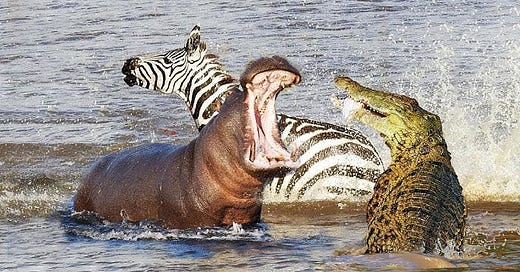Rivals in Harmony: The Complex Relationship Between Hippos and Crocodiles
Introduction
In the dark waters of Africa’s lakes and rivers, two of the most recognizable and formidable animals live together in a fragile equilibrium: the hippopotamus and the crocodile. At first look, their common environment may appear as a conflict zone. Both creatures evoke admiration due to their size, power, and instincts for survival. However, unexpectedly, their interactions exhibit an intriguing dynamic of shared tolerance, territorial regard, and behavioural complexities that underscore nature's ability for coexistence.
The following are some descriptive key points about Hippopotamus and crocodiles that highlight their unique relationship and coexistence:
Shared Habitat: The Foundation of Coexistence
Hippos and crocodiles inhabit some of Africa's most species-rich aquatic environments. These rivers—from the Nile to the Zambezi—serve as crucial lifelines, providing food, shelter, and places for breeding. Though hippos are mainly herbivores, they spend their days in water to stay cool and come out at night to feed on grasses, while crocodiles are top predators that feed on fish and sometimes land animals for their nutrition. Their concurrent existence in these ecosystems creates opportunities for distinctive behavioural interactions.
Territory Respect: Maintaining Boundaries
Although they are close to each other, hippos and crocodiles frequently exhibit an unexpected degree of territorial respect. Hippos are extremely protective of their groups and will readily charge if they sense danger. Their massive size, strong jaws, and fierce attitude render them tough opponents, even for a crocodile. This instinct for protection establishes a boundary that crocuses seldom breach.
In contrast, crocodiles generally steer clear of confrontations with full-grown hippos unless it's essential. They are opportunistic hunters and tend to target smaller or weaker creatures instead of risking a perilous confrontation with an adult hippo. This shared comprehension of limits enables both species to live together without regular aggressive confrontations.
Non-Interference with Feeding
An essential factor in their coexistence is their distinct diets. Hippos feed on plants found on land, whereas crocodiles pursue prey in water or on land. This separation in diet lowers resource competition and diminishes possible conflicts. In reality, crocodiles frequently accept hippos passing through their hunting areas, recognizing that the plant-eaters do not endanger their food resources.
In certain situations, crocodiles may even gain indirectly from hippos. While hippos feed and excrete in the water, they enhance the aquatic ecosystem with nutrients, fostering the development of fish and other creatures that crocodiles rely on for sustenance. This accidental symbiosis highlights the interrelation of their common surroundings.
Behavioural Interactions: A Study in Tolerance
The interactions between hippos and crocodiles showcase a blend of tolerance and intermittent strife. Young crocodiles and young hippos frequently show curiosity about one another, occasionally participating in playful or exploratory actions. Nevertheless, adults tend to be more careful, recognizing the dangers of crossing limits.
A notable instance of their tolerance can be observed in the dry season when water supplies diminish. Under these circumstances, both species are compelled to inhabit tighter spaces. Even in these confined spaces, overt hostility is still uncommon. This capacity to adjust and live together in difficult times reflects the survival tactics that have developed over thousands of years.
Survival Strategies: Thriving Together
For both hippos and crocodiles, thriving in Africa’s uncertain habitats requires flexibility. Hippos depend on their massive size and social behaviour to fend off predators, whereas crocodiles employ stealth and patience to catch their prey. Their strategies complement each other instead of conflicting, enabling them to succeed together.
Furthermore, their mutual presence enhances the overall ecosystem. Hippos contribute to the preservation of clear waterways by managing the growth of plants, whereas crocodiles are essential in controlling the numbers of prey animals. Collectively, they play a role in maintaining the ecological balance of their environments.
Conclusion: Nature’s Balance
The connection between hippopotamuses and crocodiles showcases nature’s skill in balancing strength and survival. Although they do not fit the typical friendship model, their shared tolerance, respect for each other’s boundaries, and complementary survival strategies let them coexist in their environment with little conflict. In their shared existence, we uncover a strong reminder of how even the most formidable beings can adjust to coexist peacefully, influencing their surroundings to uphold the complex network of life.
While we admire the rivers and lakes where these giants reside, let’s also contemplate the lessons they impart regarding coexistence, respect, and the fragile connections that unite all life on our planet.



